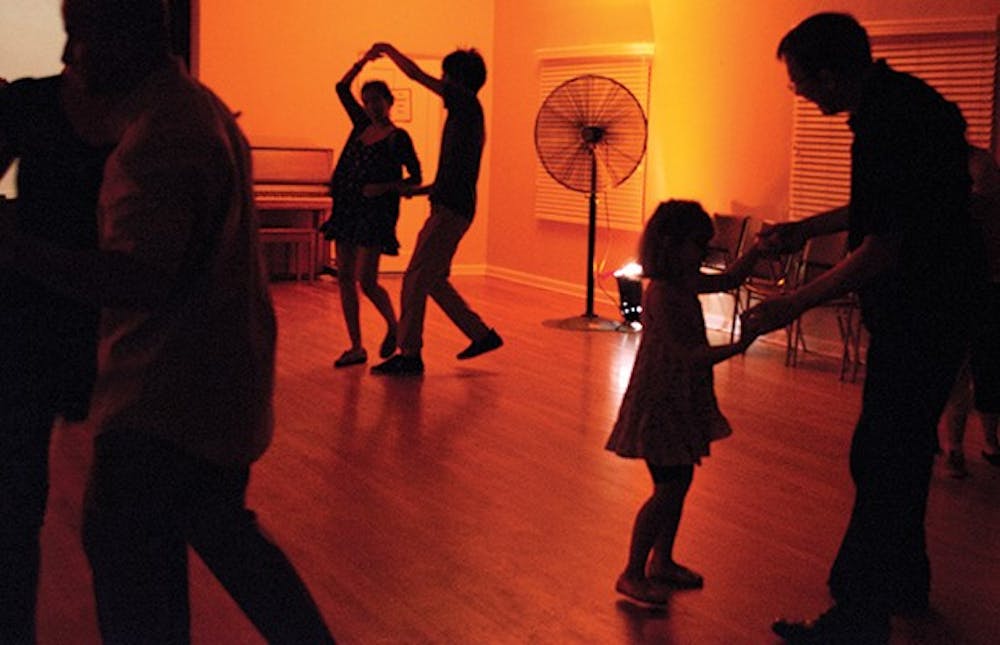Lindy Hop from The State Press on Vimeo.
As it functions, the Arizona Lindy Hop Society seems to exist inside it’s own pocket universe, defiant of our neighboring world of Twerking and the Harlem Shake.
Yet, this description alone evades why people — both young and old — continue to make the trip older than their grandparents.
Throughout the valley, including Phoenix, Chandler, Tempe and Gilbert, pupils are under tutelage of a Steve Conrad, performing a list of increasingly difficult maneuvers, for more than an one-hour before the patrons cut loose onto the dance floor.
“This a very athletic dance,’ Stan Hillhouse, one of Conrad’s frequent customers, says.
To properly describe the dance in relation to other forms of Swing Dance is to split hairs, yet for simplicity sake, it includes rapid movements of the feet, mixed with precision unmatched.
In one of the stories how the Lindy Hop formed, patrons created the dance after noted aviator Charles Lindbergh “hopped” over the Atlantic on a non-stop trip.
Let’s Dance
 Stan Hillhouse and Jo Matthews are some of Arizona Lindy Hop Society's participants with most experience.
Stan Hillhouse and Jo Matthews are some of Arizona Lindy Hop Society's participants with most experience.Photo by Luu Nguyen
On a good night, a class that Conrad teaches forms a sparsely spaced full circle. During one Tuesday at the fittingly-titled Fat Cat Ballroom, a group of about 60 people congregated into the ballroom of north Phoenix.
“Triple step, triple step, rock step,” Conrad says, one of the dozen times he’ll repeat this mantra of a guide during an evening’s lesson.
When he instructs the crowd, the maneuver appears simple — three elegant slides of the foot to the left, then quickly backtrack, followed by a splaying of the feet into a slashmark — but there’s a degree of difficulty presented.
Nuance and subtly wins the day over operatic gestures and movements.
To accomplish the side steps, the brain wants to spread the legs out into something resembling a jumping-jack position, but this is wrong.
Instead, it requires small delicate slides, with the momentum provided by the right foot.
Still, some of curriculum does boil down memorization, yet not an overreliance of it.
For an uninitiated onlooker, the view of the two pairs of feet swaying in step with another in quick succession easily distorts a perceived difficulty, yet all the dance moves that follow consists of the same variations of these initial moves.
When the male lead wants to spin his female counterpart he applies the right hand on the woman’s back then uses the position to push her outward, while his left hand and her hand remain connected.
It is a craft that takes time, patience and practice — lots of it. However, once people work out the kinks and psychological roadblocks, the untrained eye can easily fool the amateurs as professionals.
Such is the case with Jo Mathews and Hillhouse, two friends who arrived to dance at Conrad’s monthly dance on Thursday at the “Swing Lounge,” on the northwest corner of Mill Ave and 13th Street.
While it goes without saying Mathews dances professionally, as evidence from skill presented on the floor. When asked how much of Hillhouse’s knowledge emerged from a formal education, the response was surprising.
“Zero,” he says.
It shouldn’t be surprising that certain people display professional prowess on the dance floor, yet the astonishment still registers.
The two dance as if they share telepathy of the other’s forthcoming steps; every twirl or spin comes across as practiced and telegraphed, yet intuitively they cannot be.
“There’s no such bad moves, just new moves,” Hillhouse says, referring a common colloquialism of Conrad. “That’s one of his sayings.”
Good Vibrations
Then there’s Steven Conrad himself, an upbeat man of unparalleled energy and drive. Some go door to door and sell a Watchtower, but for him he’s touting a power of another connection: a physical one.
A quick look at the Arizona Lindy Hop Society’s calendar reveals an influx of events where he will pitch the dance to those who come.
He hosts all of these events around the Valley in a week. On an average week he’ll coordinate and repeat a warm-up exercise about impersonating a Motown backup dancer to least three sets of audiences of a dozen or more people.
Conrad says he’ll be on the road sometimes six days of the week. He repeated this process, every week, except for a year when his son was born, for the last 18 years.
And the results in the ballrooms substantiate his claim.
While his students move at quarter of the pace to accomplish one small fraction of the dance, Conrad demonstrates at full speed, where at least two decades of practice reduced difficult maneuvers to comfortable muscle memory.
Over the course of a 90-minute session, a v-shaped trail of sweat begins to form at his neck and gradually trickles down the center of his white button-down shirt.
At the end of only an hour of instruction, the sweat reached the second button and within an half an hour, it’s gone down two more buttons.
Soon thereafter, two pairs of rectangular secondary sweat marks appear over his shoulder blades, the environmental conditions being the only remnants of the exertion called for to perform the Lindy Hop.
The Joy and The Ecstasy
For this event in Tempe, some invested themselves more than others in the act itself. Female students no older than freshmen arrive dressed in neo-period dress. Some of the vendors selling period fedoras arrive in zoot suits with hats.
“I’ve actually run about 3,000 Lindy Hop events, and lemme tell you, we pack those places,” Hillhouse says. “It’s not necessarily older people that remember this, but a lot of younger people are into this. And if they see it once or twice, they're hooked."
Such is the case with chemistry junior Buapha Laophio, who is new to the dance and its initial awkwardness but plans to continue attending.
The same goes for global studies freshman Camille Gribbons who enjoys dancing’s rhythms and conditions.
“There’s a level of intimacy set by dancing with someone, you’re touching them, but it’s not in a raunchy way, but it’s still seductive,” Gribbons says.
In other words, it forges physical contact (touch) and then feasibly relationships.
“You can’t worry about if you’ve messed up a step, and you can’t think what to do in a couple seconds, you have to be completely present with that person for it to work," Conrad says. "So if the two of you, as partners, are present, then an amazing thing happens, you connect with the music and you connect with your partner, and you loose yourself for a little while.”
Reach the writer at tccoste1@asu.edu or follow him on Twitter @TaylorFromPh





